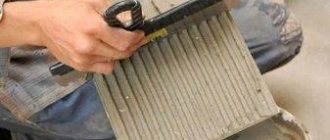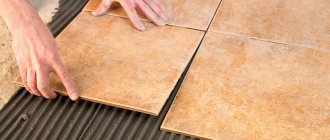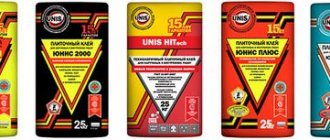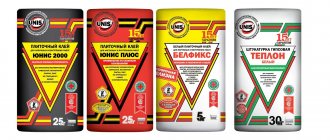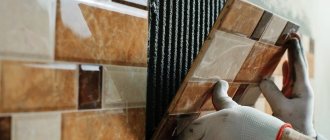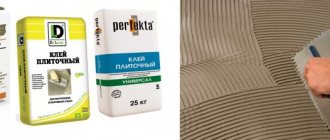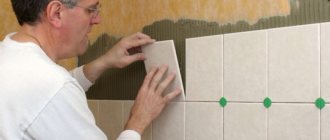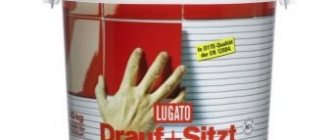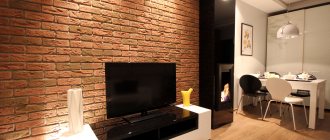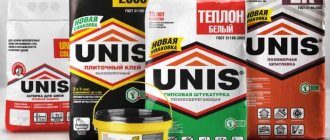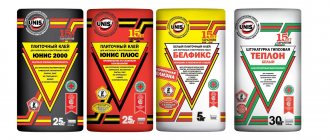Often there is a need to tile the floor, walls or garden path. In this case, in addition to the tile itself, you also need to acquire tile adhesive. And here there are many snags, especially for those who are doing this for the first time. Which brand is better? What adhesive is best for this tile? How much will it be needed?
Eunice glue
Options for approximate calculation of the amount of tile adhesive
As is clear from the table presented, the values are approximately the same and do not mean much. It is better to estimate the consumption of tile adhesive per 1 m2 using the calculator that each manufacturer presents on its website.
In order to use this service, you need to know the area of the room, decide on and select the type of mixture. As a result, you will be given the result in kilograms.
Another simplified calculation option under optimal conditions of use: half the thickness of the panel is multiplied by the solution consumption indicated on the packaging, the result will be the desired glue consumption per 1 m2.
To correctly determine the required amount of mixture, you need to take into account all the factors influencing this value.
Factors affecting glue consumption
The first thing the mixture consumption depends on is the type of surface and its general condition. The smoother the wall and the fewer irregularities and cracks there are, the less glue is used. That is why professional builders recommend pre-preparing the base using a less expensive finishing material such as plaster.
In addition, the back side of the tile may also have an uneven surface, and then an additional layer of mortar is applied to it.
The next parameter that determines the required amount of glue is the material of both the wall and the tile itself.
Each material has its own porosity, depending on which it has a certain absorbency. For example, concrete walls absorb the least amount of mortar. To reduce the consumption of tile adhesive per 1 m2, the base is carefully treated before
Tiles are also made from different materials. The smallest amount of glue disappears on porcelain stoneware panels, the largest porosity is on cotto tiles.
The size of the panels also plays a role; the larger the tile, the thicker the layer should be.
Much depends on the installation method and the professionalism of the craftsmen. The more experienced the finisher, the thinner the layer of glue he can apply without losing the quality of the fastening.
Instructions for use
Work is permissible at air temperatures from +5 to +30 °C and relative humidity less than 75%.
Surface preparation
Before starting work, it is necessary to carry out traditional preparation of the base:
Laying on flat walls and floors will be faster and better quality
Remove old finishes, old crumbling plaster or screed. Level the base. Allowable height differences are 1 mm per 1 meter. Cracks and defects with a depth of more than 10 mm must be leveled with plaster. The manufacturer recommends using Eunice “Silin”, “Teplon” or “Standard” plaster, depending on the situation. When laying on old tiles, to improve adhesion on the old cladding, notches are made in a checkerboard pattern every 5 cm. Dry and degrease the surface. In damp and basement areas it is recommended to apply coating waterproofing using UNIS GIDROPLAST. To improve adhesion, the surface must be treated 1-2 times with UNIS primer. Highly absorbent surfaces (gas silicate, foam concrete) must be treated especially carefully. There is no need to wet the base or tile first.
On an uneven base, the layer of glue will be uneven, which means it will set and shrink at different times. This can cause peeling or cracks in the tiles.
Mixing the solution
Mix until smooth and without lumps
To mix the solution, you need to use a clean tool and container. The dry mixture is poured into a container with clean water in the specified proportions (see table of technical characteristics or instructions on the package). The solution must be mixed until a homogeneous consistency is obtained within 3-5 minutes. The solution should ripen in a calm state for 3-5 minutes, after which it must be mixed again. Mixing can be done by hand or using a construction mixer/drill with an attachment at low speed. When mixing by hand, a portion of the mixture should not exceed 1 kg in weight. The prepared solution must be used within 180 minutes (300 minutes for the HiTech mixture). If the mixture thickens within this time, it must be stirred without adding water. If the specified proportions are not observed when mixing or adding other components, the properties of the adhesive may deteriorate.
Applying glue
Applying glue with a comb
- Using a trowel or a regular spatula, apply the prepared solution in a layer of 3-15 mm to the prepared surface and level it with a notched trowel or trowel.
- For large tiles and porcelain stoneware, the teeth must be at least 8 mm in size. The weight of large tiles should not exceed the maximum permissible.
- The tile is pressed onto the adhesive layer. The glue should be evenly distributed under it, avoiding the formation of voids. To do this, you can press the tile with wave-like movements, or tap it with a rubber hammer. After pressing, the thickness of the adhesive should not exceed the maximum permissible value (see characteristics table).
- Apply glue to the area that you will have time to cover during the lifetime of the solution (10-20 minutes). After this, adhesion will deteriorate.
Press the tile firmly to distribute the mortar
When working externally or fastening marble slabs, light limestone, large tiles or with different thicknesses and reliefs, the mixture must be additionally applied to the working surface of the tile. After laying, there is another 10-20 minutes to adjust the position of the tiles. Level its plane. To maintain uniform seams, use plastic crosses. After 24 hours, you can start walking on the tiles and start grouting the joints using UNIS COLOR colored grout mixtures. The heated floor system can only be used 28 days after installation.
comments powered by HyperComments
Types of glue
Before determining the consumption of tile adhesive per 1 m2, you need to choose what composition will be used. There are three main types of tile mixture:
1. Dispersion - a ready-made composition, extremely convenient in that you do not need to spend time on its preparation. It is good because it has ideal plasticity and viscosity, allowing you to apply the solution in an optimally thin layer.
2. Cement-based adhesive, the most inexpensive mixture, which is sold dry and needs to be diluted. Thanks to its cheap components, it is very popular and is used in 80% of cases. This type has its own method of calculating consumption, approximate, but giving at least some idea of the required quantity. To determine the consumption, you need to know the thickness of the adhesive layer, which is calculated based on the size of the tile. We multiply the thickness by 1.3 (this is the average weight of the tile adhesive) and get the desired result.
3. Epoxy mixture is usually used by professional finishers, since its production requires some experience. For dilution, a special catalyst is used, which provokes a chemical reaction.
additional information
The Unis company is a Russian manufacturer of dry construction mixtures, which have been consistently in demand for over two decades. The company's products are among the three most popular products. Unis 2000 adhesive can be used to lay marble, limestone and granite tiles, but not thicker than 1 cm. When working with such materials, you can use both serrated and regular spatulas or trowels. In the first case, grooves of given sizes are obtained, and in the second, the thickness of the created coating can be increased.
The maximum thickness of the adhesive layer is used in cases where it is necessary to smooth out the most powerful differences in height. If the base is so chaotic, sometimes it is more advisable to resort to leveling with plaster or screed in order to save time and increase the reliability of laying the tiles. Remember that the smallest layer of adhesive in a particular case is equal to or greater than the thickness of the tiles.
When mixing dry material, it is advisable to use a mixer, ensuring that the smallest lumps disappear completely. Strengthening, like all cement-based compositions, takes 28 days, and during the first 14 days it is not advisable to grind the seams. Glue cannot be used on top of a heated floor. Having familiarized yourself with the properties of the mixture, it is easy to understand that it satisfies even the most stringent technological requirements, provided that the manufacturer’s recommendations are followed.
More details about tiling work using Unis 2000 adhesive are described in the video.
Spatulas used during work
A lot also depends on the size and type of spatula. To apply the solution, use a spatula of a certain shape. If it is incorrectly selected in size, then the consumption of tile adhesive per 1 m2 increases significantly.
The recommended type of spatula is often indicated on the packaging; in this case, it is better to listen to the manufacturer and purchase it. In addition, it is recommended to adhere to the following rules:
1. Glue consumption directly depends on the angle of inclination of the spatula during application; the greater the inclination, the greater the consumption.
2. The most glue is consumed when applying the solution with a spatula with square teeth; the most economical option is a V-shaped tool.
Pros and cons of Unis tile adhesive
As you can see, Unis tile adhesive has many advantages. They should also include the fact that it is quite simple and convenient to work with such a composition. The manufacturer provides detailed instructions for using its products, so even the least experienced tiler can easily navigate it.
The disadvantages include not the lowest cost of glue. It mainly depends on the specific subtype of the composition, but in general you can find a more budget-friendly option on the market. However, the amount on the price tag fully justifies the decent quality and excellent performance indicators of the material.
So how much glue should you buy?
Experts suggest taking 10 kg of glue per 1 m2 for a layer thickness of 10 mm as the norm. Even if you do it yourself, it will be more than enough. In order to reduce the consumption of tile adhesive per 1 m2, professional advice suggests carefully studying the technology of applying the solution and following the recommendations from the manufacturer.
During construction work, it is very important to pre-calculate the amount of material in order to correctly draw up an estimate and not overpay for unnecessary products. How to calculate the consumption of tile adhesive? It’s very simple, use our online calculator and you will find out how much tile adhesive you will need depending on the layer of mortar. The calculator will calculate the consumption of tile adhesive Yunis, Osnovit, Liktol, Volma. The materials calculator will help you find out how many bags of glue you need to purchase and what the total weight of the cargo will be.
Choosing glue
To choose the right dry mixture from Eunice, carefully read the comparison table, which presents the entire range of products of this company:
- Yunis XXI tile adhesive has two release options - exclusively for internal work (place of production in Moscow), and internal/external work (place of production in Chelyabinsk and Ulyanovsk).
- Prices are as of 2015.
Eunice Plus
The main distinguishing feature of Eunice Plus glue is its versatility. You can lay tiles, mosaics, stones, and porcelain tiles on it. Another significant advantage of this material is strength. Adhesion of ceramic tiles and porcelain stoneware is 1.25 MPa, can withstand a maximum weight of 100 kg/m2. You can carry out both internal and external work, except for cladding the basement floors. It is used to make complex bases under heated floors and even on top of old tiles. It is certified as a material safe for health, therefore it is approved for use in gardens, schools and other institutions. Placed on a solid base - non-deformable concrete, cement, brick, plaster.
Unis 2000
Using Unis 2000 tile adhesive, they glue wall and floor ceramic tiles and porcelain tiles measuring 60*60, and perform interior and exterior work. Can be used as a leveling layer that perfectly fills unevenness on the base during the laying process. Suitable for durable concrete, gypsum, cement and brick substrates.
In terms of safety, it is completely analogous to the previous composition.
Eunice XXI
Yunis XXI tile adhesive is used to perform standard interior and exterior work - tiling floors and walls with regular tiles. It is used in rooms with high humidity and the likelihood of freezing in winter. Suitable for laying small porcelain tiles - within 30cm and exclusively on floors.
- Maximum loads in subzero temperatures are possible only after 28 days, and then only if during this period there was no systematic contact with water.
- UNIS XXI tile adhesive has two release options - exclusively for internal work (place of production in Moscow), and internal/external work (place of production in Chelyabinsk and Ulyanovsk). If internal work is carried out, then the layer should be a maximum of 10mm, if external - 15mm. The adhesion level is 0.5 and 0.7 MPa, respectively.
Eunice HiTech
The main purpose of the HiTech mixture is to work with complex bases: ceilings, walls, floors. Laying can be done not only from the floor, but also from the ceiling. It has a fairly long solution life. Can be used in children's and medical institutions. One bag weighing 25 kg is used for 7 m2 of cladding.
Eunice Granite
Using Eunice Granite tile adhesive, large and heavy floor slabs made of natural stone and porcelain stoneware are laid. Floors, walls, facades, plinths are covered. Can be laid on top of old tiles and underfloor heating systems. The glue has a fairly thick consistency, so it does not slip during the hardening period. Can be used in children's institutions.
Yunis Granite is distinguished by increased adhesion strength - 1.5 MPa. If we compare with the same indicator from other manufacturers, we see that Hercules Elastic GM-195 has exactly the same, and Ceresit SM 17 has only 1.3 MPa.
Eunice Belfix
The Eunice Belfix mixture is available in a non-standard white color, because it is used for laying marble, glass mosaics, and natural stone, for which the usual cement mixture is strictly contraindicated. It is characterized by increased elasticity and frost resistance. Place of application: walls, floors, liquid tanks, rooms with high humidity, outdoors, heated floors. Can be used as grout. The cost is higher than other types of adhesives - for a 25 kg bag you need to pay 418 rubles.
Unis Fix
Relatively inexpensive, but not the most reliable glue. It has a fairly high consumption and does not appear on sale often. It is used for tiling work on walls and floors in the bathroom, kitchen, terrace, and balcony. Works with regular tiles.
How much tile adhesive is needed?
First of all, you need to pay attention to the approximate consumption of material indicated on the packaging bag. Of course, these are only approximate figures, because the residual result will depend on many factors:
- uneven walls;
- comb selection;
- comb tilt;
- tile porosity;
- size and type of facing tiles;
- the dexterity of the master and his professional skills;
- temperature indicators.
Thanks to fast online calculators, you can find out how much tile adhesive is needed and reduce the likelihood of error to a minimum and make more accurate tile adhesive consumption per square meter.
To do this, you need to indicate in the proposed table the surface area, the thickness of the intended layer and the type of glue. If there is a tile measuring 20 by 30 cm, then it should be applied with a thickness of no more than 1 cm. The final figure helps the master determine the amount of tile adhesive to purchase for the floor from the walls in the bathroom to the entire surface.
Also use the consumption calculator: Tile adhesive consumption depending on the structure and parameters of the tile
Attention: the larger the tile size, the larger the layer of adhesive that needs to be applied. Using a tile adhesive calculator ,
These parameters must be accurately specified in order to minimize possible errors. For larger elements, the glue is applied in a layer of 5 mm.
Highly porous products require one and a half to two times more glue than materials with a low degree of absorption. For ordinary repair work, a universal product will be just right - glue based on a cement-sand mixture.
Other factors that can affect the unexpected consumption of tile adhesive are the workman’s manner of work, strictly adhered to the permissible time for.
It is important to follow the manufacturer’s instructions and mix only the amount that can be worked out in 1–2 hours, this is due to the hardening of the solution. This will prevent you from throwing away spoiled solution and will save your budget.
Using a tile adhesive consumption calculator,
You can decide in advance on the number of bags of adhesive composition, and in order to achieve more accurate results, you can purchase a little mixture and, knowing the exact coverage area.
The result obtained in this way will be more truthful, and the online assistant will help every master.
Good luck with your renovation and minimal consumption of building materials!
Not so long ago, interior decorators mixed solutions for laying ceramic tiles on their own, using preparation recipes known to them. Nowadays, this issue is much easier, since stores offer a wide range of ready-made adhesive mixtures for laying tiles.
Working with high-quality glue is a pleasure: it is easy to prepare, very flexible, and has excellent adhesion. If the required amount of material is purchased in advance, the installation process can proceed almost non-stop. A calculator for calculating the amount of adhesive for laying tiles will help you determine how much mixture you need to purchase for the planned volume of cladding.
A brief explanation of how to use the calculator is given below.
Tile adhesive is used for laying ceramic and porcelain tiles, allowing you to finish the room with extreme simplicity. It is presented on the market in a wide range, differing in brand, main components, type of material with which it can be used, hardening time and other characteristics. Depending on the type of product, its average consumption will also differ, which is also important to know in order to calculate the optimal purchase volume. Now the only task left is to determine the numbers that will help purchase the required volume of the adhesive mixture. A special calculator will help you calculate the consumption of tile adhesive per 1 m2; you can also do this using other methods. Let's consider all possible options.
| Side size of a square tile (when using rectangular tiles, the calculation is based on the area) | Recommendations for using a notched trowel (recommended trowel tooth size) | Layer of adhesive application after pressing the tile - 1 (trowel angle 45°), mm | Layer of adhesive application after pressing the tile - 2 (trowel angle 60°), mm |
| Up to 5 - 7 cm | 3 mm | 1,1 | 1,3 |
| Up to 10 cm | 4 mm | 1,4 | 1,7 |
| From 10 to 20 cm | 6 mm | 2,1 | 2,6 |
| From 20 to 30 cm | 8 mm | 2,8 | 3,5 |
| From 30 to 50 cm | 10 mm | 3,5 | 4,3 |
| Over 50 cm | 12 mm | 4,2 | 5,2 |
Quantitative ratio
Tile adhesive is packaged in bags
The following link describes which adhesive to choose for laying tiles in the bathroom. Frost-resistant tile adhesive is suitable for exterior work.
To determine the consumption of tile adhesive, several options are used:
- The first calculation method is advisable to use for those who have already purchased glue again and know how to work with it. If you trust the same manufacturer, then you can go to their website and calculate the consumption using the “Online calculator” function available there. The program will only require you to enter the size of the tile, the area of the room and the type of adhesive. After this you will receive a value that will be expressed in kg.
- The second option is more complicated, because here you will have to carry out a number of calculations. Let's look at this using cement-based adhesive as an example. Let the installation process be carried out in favorable conditions. Accepts 1.3 kg glue consumption. Now it’s worth multiplying this figure by the layer thickness (if you use 30x30 cm tiles, then the layer thickness will be 4 mm). The result is 5.2 kg/m2. If you lay 10 m2 of tiles, the consumption will be 52 kg. Tiles with other dimensions have their own layer thickness. But even this result cannot be called accurate, because everyone can use their own glue that has certain properties. This way you can get an approximate result.
- The third option should be used by those who want to urgently obtain data on the consumption of tile adhesive. For these purposes, it is necessary to take into account such parameters as ½ the thickness of the tile, the average consumption of the glue used. When you multiply these indicators, you will get the desired result. But this option is one of the most inaccurate, because even porcelain tiles from the same batch can have different thicknesses.
Features of automatic counting
To calculate the volume of material quickly and accurately, you can use a special calculator. It is easy to find on any specialized website on the Internet. To determine the average consumption of tile adhesive per 1 m2 of tiles, you will need to enter the following criteria in the empty fields of the form:
- size of one ceramic tile element;
- type of facing material: tile or porcelain stoneware;
- work option: internal or external;
- base: wall, floor;
- base: cement, concrete, plaster, metal, self-leveling floor, etc.;
- features of operational loads;
- composition characteristics;
- total surface area.
You will receive the result within a few seconds after starting the process. You will be presented with the consumption of tile adhesive per 1m2 and for all work in general. To get precise confidence in the correctness of the available data, you can use several resources by comparing the calculated indicators. The advantage of this method is its efficiency.
How to calculate it yourself
A calculator is a handy thing, but if you doubt the accuracy of the data provided, perform the calculations yourself. To do this, first of all you will need to determine the thickness of the adhesive layer. It varies depending on the size of the tile itself:
- small tiles, mosaic – 2-3 mm;
- average element size – 3-5 mm;
- large tiles - 6-9 mm.
If we are talking about porcelain stoneware, the layer thickness will increase to 17-20 mm, because the material is heavy and must be securely fixed.
Important! There is no need to exceed the optimal layer thickness, otherwise it will take a long time to dry. Standard indicators should be adhered to.
When making calculations, it is necessary to take into account the features of the surface itself. For example, if we are talking about finishing the floor with standard ceramic tiles, the thickness of the pillow will depend on the presence of unevenness on the base:
- flat surface – 4 mm;
- floor with minor defects – 7-9 mm;
- base with noticeable level differences - up to 20 mm.
Attention! In case of significant unevenness, the highest point should be taken as the level. So all the depressions will be filled with a special composition. If the base has large depressions, a leveling screed must first be made.
Now we begin to determine the optimal consumption of tile adhesive per 1 m2. Initially, you need to study the product packaging, finding here the standard recommendations from the manufacturer. They are indicated taking into account a layer thickness of 1 mm, as well as a flat surface. Now determine the height of the adhesive pad for your case, multiply it by the basic indicators taken from the packaging. You have received the average consumption rate of tile adhesive per 1m2. Multiply this figure by the number of squares to be finished. Be careful! Add another 10% to the existing figure to eliminate the possibility of shortages due to minor costs and unforeseen circumstances.
How to apply?
Once the surface is prepared and the glue has a uniform consistency, you can begin applying it to the wall or floor.
This process will require a spatula. Using it, an even layer of the composition with a thickness of 3 to 15 millimeters is applied; we must not forget to level it using a special grater or a spatula with teeth. If the squares of the tiles are large, then the teeth should be from 8 millimeters.
It is important to ensure even distribution of the adhesive mass. Voids will lead to unpleasant consequences in the future, so it is better to press the tiles a little to the surface
After the material has been laid, it can still be adjusted within twenty minutes. The glue dries in just one day. Then you can move freely on the tiles (if the finishing work was done on the floor). After completing the work, you need to remove the excess adhesive mass that remains on the front of the tiles and the grout joints. If excess compound remains in the joint, a number of problems may arise when grouting begins.
Possible consequences.
- If you apply grout to an uncleaned seam, then later it will begin to crack because it will be thin.
- Another reason why it is necessary to remove glue residue is aesthetics. If the adhesive mass shows through the grout, then no matter how beautiful the tile is, its appearance will be ruined.
- Using colored grout on a seam with glue residue will result in the fact that after drying it will differ in color from the rest of the grout. The thing is that in this place it will be thin and not so strong. The result will be sloppy.
To avoid these unpleasant consequences, you need to remove the remaining glue while it is in a soft state, otherwise it will be much more difficult to do this later. For the procedure you will need a knife. Using its blade, it is easy to remove the remaining adhesive from the edges of the tile.
If the mixture has already hardened, then you need to use a special knife, which is designed for the grout joint. First, make a cut in the center of the seam and use a knife to scrape off the dry adhesive from the edge of each tile. If necessary, you can clean the tiles using an abrasive float. And at the end of the procedure, the seams are cleaned with a vacuum cleaner so that not a single small particle remains of the glue.
Differences by product brand
It was mentioned above that the consumption rates of the mixture depend not only on the type of finishing material and base, but also on the manufacturer and the composition of the product. Take this into account too. For example, tile adhesive Eunice Granite has a consumption per 1 m2 of 3.5 kg. The numbers will be relevant provided that a 6x6 mm comb is used. The optimal layer thickness is 3-5 mm, the maximum is 10 mm. The consumption of Eunice Plus tile adhesive per 1m2 will remain within the same limits.
The product Unis 2000 is often used in finishing work. It is used in exterior and interior decoration. The composition is capable of holding tiles on the surface, creating a load of up to 80 kg per m2. The thickness of the pillow is 3-15 mm. Average consumption when using a 6x6 mm spatula is 3.5 kg. If we talk about the Ceresit product, it is consumed in a volume of 1.7-4.5 kg per m2, depending on the type of surface and type of finishing material. As for another, no less popular product - EK 3000, it will require approximately 2.8 kg per square meter if the mixture is laid with a 6x6 mm spatula.
What is good about Eunice glue?
The use of modern fillers improves resistance to moisture and cold, and increases the adhesion strength of the product to the base. The glue holds well not only tiles, but also heavy natural stone. At the same time, masonry can be performed on a variety of surfaces - from brick and concrete to plastered walls
You can mix the glue not only using mechanized methods, but also manually, which makes it possible to use it at home. It takes about 180 minutes to use the solution, which is quite enough for laying the material in rooms of different sizes. The product is supplied in convenient packaging that is easy to transport in any car.
Main characteristics
- The composition can hold tiles weighing one hundred kilograms per square meter.
- The pot life of the adhesive is about three hours; it takes twenty minutes to lay the tiles, and ten minutes to adjust it. The composition will harden after a day, and you can safely walk on the tiles.
To dilute the product, packaged in a 25 kg bag, you will need 4-6 liters of water. In this case, masonry can be carried out at temperatures from +5C to +30C. If you apply a layer of glue 3-15 mm thick, the consumption of the product will be about four kilograms per square meter.
It is no coincidence that these adhesives are used to work with complex surfaces. They provide high adhesion strength, so installation can even be done using the top-down method.
Adhesives can also be used on heated surfaces, for example, on “warm floors” heated to a temperature of 40C.
Clay Eunice 2000
Purchased glue in original packaging can be stored for one year, observing the manufacturer's requirements for humidity and ambient temperature.
In terms of the combination of price and characteristics, Eunice adhesives are deservedly considered one of the best building materials on the market. VIDEO ON THE TOPIC
How to dilute and work with Eunice tile adhesive
The preparation of the Unis 2000 tile adhesive solution is carried out in accordance with the manufacturer’s recommendations, which are set out on the product packaging. Only clean containers and tools should be used.
Stages of dilution and use of Eunice glue:
1. Pour the dry mixture into a prepared container with clean water and stir until a homogeneous mass is obtained for 3-5 minutes.
2. Let stand for 3-5 minutes and mix again. When mixing, do not add more dry mixture or water to the composition.
3. The resulting solution must be used within 180 minutes.
Important information:
- Adhesive compositions should be used for cladding durable, non-deformable bases. Work should be carried out in dry conditions at air and base temperatures from +5C to +30C and relative air humidity not exceeding 75%.
- When performing external cladding, direct sunlight is not allowed on the cladding surfaces.
4. Using a trowel or spatula, apply the prepared adhesive solution with a thickness of 3 to 15 mm onto the prepared primed base or work surface and level it with a notched trowel. For large-format ceramic tiles, use a spatula with teeth of at least 8 mm.
When covering walls, the weight of large-format tiles should not exceed the weight indicated on the packaging.
5. Place the tile on the layer of glue and press down. Its inner surface should adhere tightly to the adhesive solution. When applying adhesive to substrates, the mortar mixture should be applied to an area that can be covered within 10 minutes.
We control the installation by level. If necessary, the position of the tiles can be adjusted within 10 minutes after installation. During the same period, the surface of the tiles and joints should be cleaned of excess glue.
Subsequent grouting of the seams of wall and floor tiles with Eunice Color colored grouts can be carried out 24 hours after tiling.
